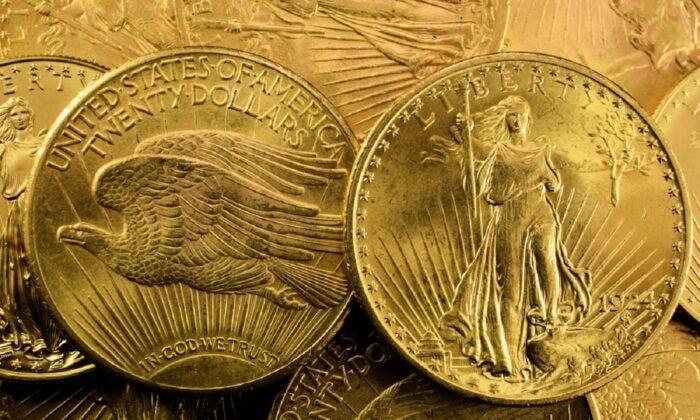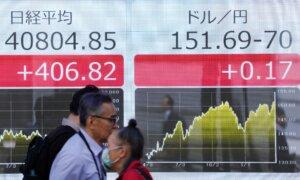Gold prices hit a record high on Thursday after U.S. Federal Reserve Chair Jerome Powell suggested that the agency will start cutting rates this year, a development that is typically bullish for the metal.
Spot gold prices broke above the level of $2,300 per ounce in early trade on April 4, hitting a new record high. Since March 25, gold prices have risen every single day for seven straight trading days. On Thursday, spot gold was trading at $2,291 per oz. as of 12:30 p.m. EST, up 5.89 percent from $2,163.50 on March 25. The record high in gold prices came after Mr. Powell indicated there will not be any more rate hikes and that the agency would start cutting rates this year, as expected by many investors.
“We have held our policy rate at its current level since last July. As shown in the individual projections the FOMC [Federal Open Market Committee] released two weeks ago, my colleagues and I continue to believe that the policy rate is likely at its peak for this tightening cycle,” Mr. Powell said during a speech at the Stanford Graduate School of Business, Stanford, California, on April 3.
Gold and interest rates are thought to have a negative correlation—that is, declining interest rates make assets such as gold attractive to investors.
According to data from the CME FedWatch Tool, more than 93 percent of interest rate traders do not expect the Fed to cut rates from the current level in the agency’s upcoming meeting in May. However, over 58 percent expect the Fed to reduce rates by 25 basis points at the June meeting.
In addition, ongoing global conflicts and elevated inflation are acting as long-term support for gold. When investors are wary of high inflation, they tend to flock to gold as a safe haven, which pushes up its price.
“Gold prices have officially crossed above $2,300 for the first time in history. Since February 14, gold is up an incredible $300/oz. or 15 percent in less than 2 months,” The Kobeissi Letter, a commentary on the global capital markets, said in a post on X on April 4.
Gold Prices in 2024
JP Morgan is holding a bullish view on gold for 2024. “Across commodities, for the second consecutive year, the only structural bullish call we hold is for gold and silver,” said Natasha Kaneva, head of Global Commodities Strategy at JP Morgan, according to a January report by the group.Gregory Shearer, head of Base and Precious Metals Strategy, said that JP Morgan sees gold and silver to remain bullish well into the first half of 2025.
A February report by Goldman Sachs pointed out that downside risks to gold prices this year are expected to be limited since “central bank purchases are strong and geopolitical tensions are high.”
“Gold buying by central banks—particularly from China and India—have helped offset money flowing out of gold exchange-traded funds. Those purchases have been driven in part by geopolitical tensions, such as Russia’s invasion of Ukraine, and the COVID pandemic,” the report stated.
“Central banks bought an average of 1,060 tonnes from 2022 to 2023, compared with 509 tonnes bought between 2016 to 2019. The increase comes as China shifts reserves away from U.S. dollars and countries such as Poland also ramp up their gold reserves.”
“Although we still view a material resurgence of inflation as a remote possibility, this scenario would likely be positive for gold, as it undermines monetary policy and risks an even harder landing further down the road.”
In the less probable “hard landing” scenario—25–55 percent probability—the WGC expects gold prices to move “notably higher” and hit a new record high.
If the U.S. economy sees a “no landing” scenario whereby inflation and economic growth reaccelerate, the WGC foresees gold prices to remain flat and face downside pressure. The “no landing” scenario has the lowest probability, at just 5–10 percent.
In 2024, the WGC expects major global elections in the United States, India, the European Union, and Taiwan to be a geopolitical risk. As such, “investors’ need for portfolio hedges will likely be higher than normal,” it stated.
“The probability of a recession is not insignificant. From a risk-management perspective, this would provide strong support to the case of maintaining a strategic allocation to gold in the portfolio.”







